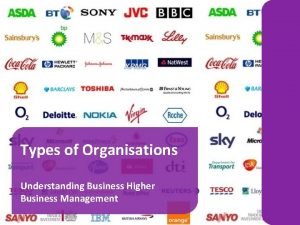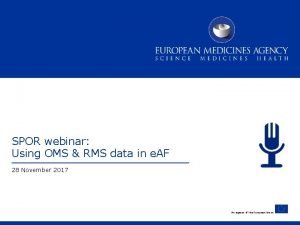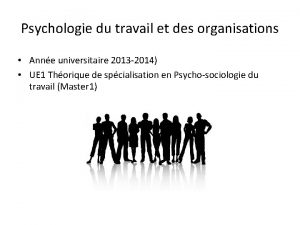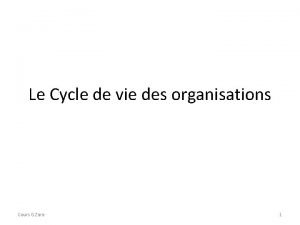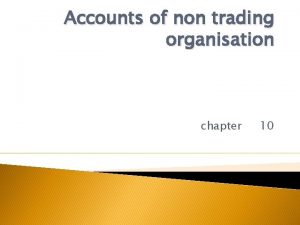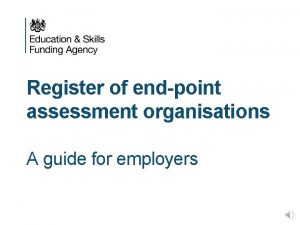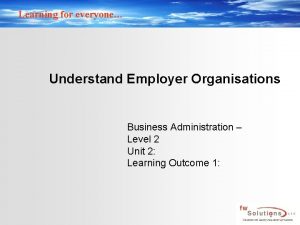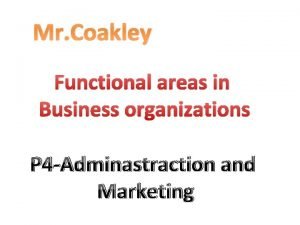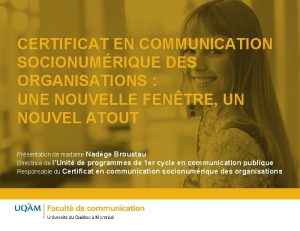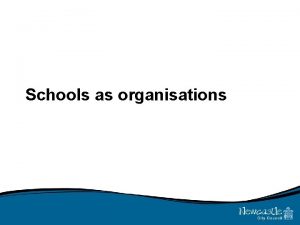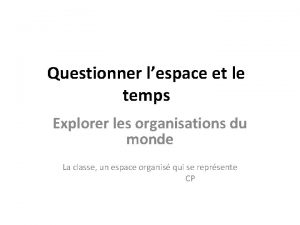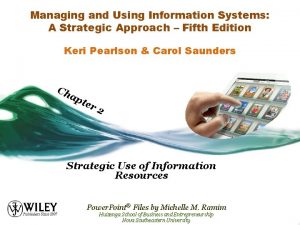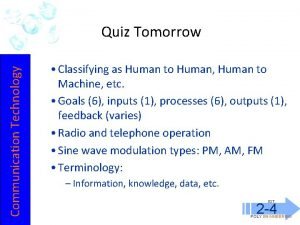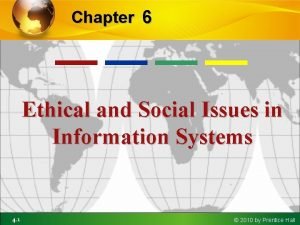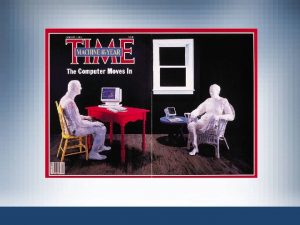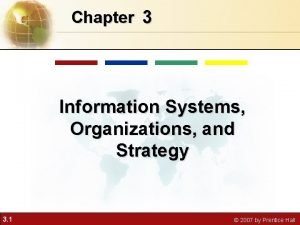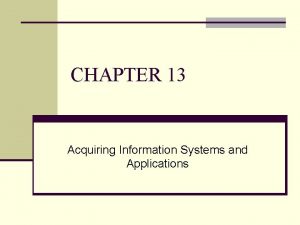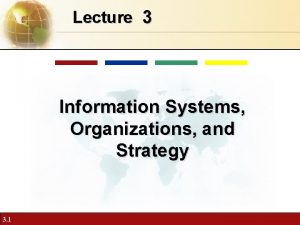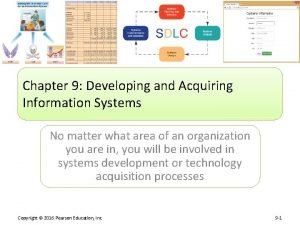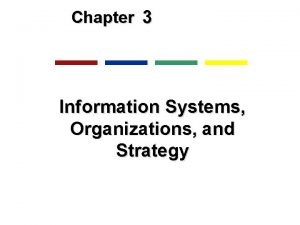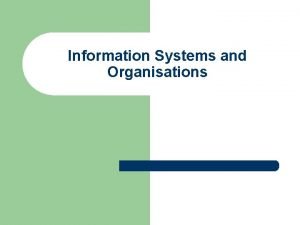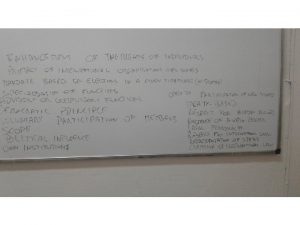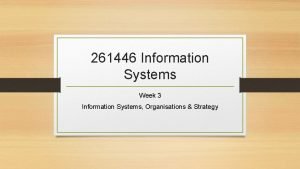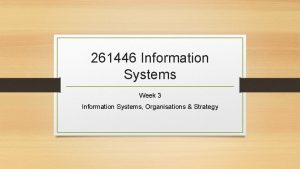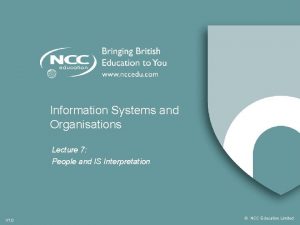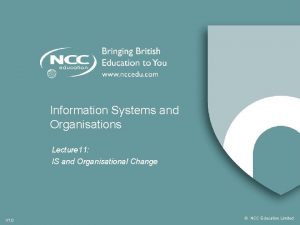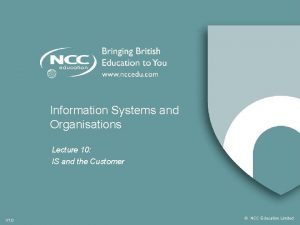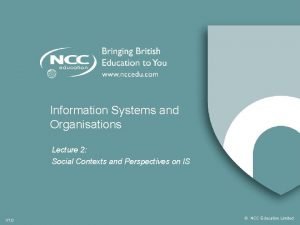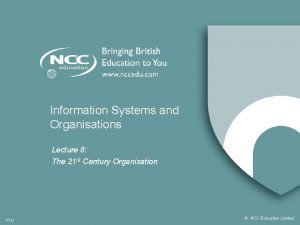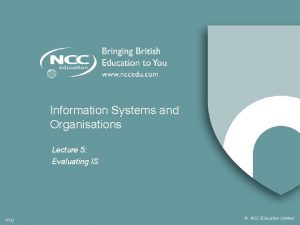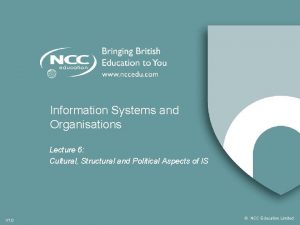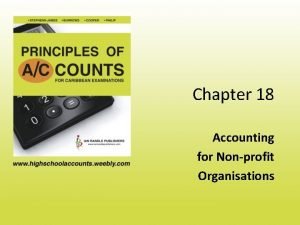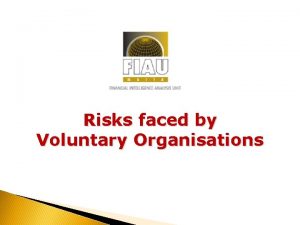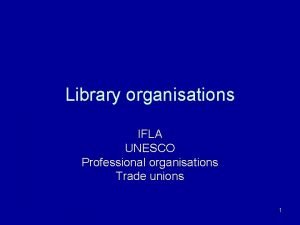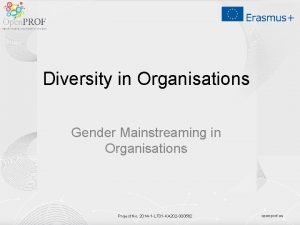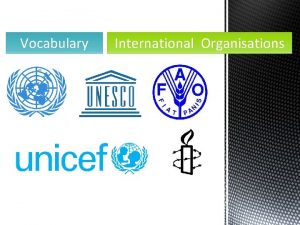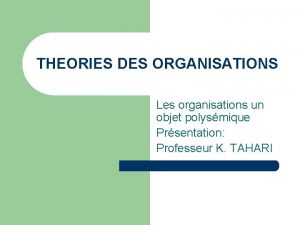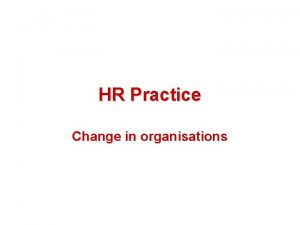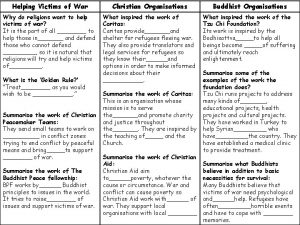Information Systems and Organisations Lecture 1 Organisations and






























- Slides: 30

Information Systems and Organisations Lecture 1: Organisations and Information Systems V 1. 0 © NCC Education Limited

Organisations and Information Systems Lecture 1 - 1. 2 Scope and Coverage This topic will cover: • Data, Information and Knowledge • Uses and importance of Information Systems (IS) to organisations V 1. 0 © NCC Education Limited

Organisations and Information Systems Lecture 1 - 1. 3 Learning Outcomes By the end of this topic students will be able to: • Explain ways in which data, information and knowledge are used in organisations • Appreciate how Information Systems influence the nature and success of organisations V 1. 0 © NCC Education Limited

Organisations and Information Systems Lecture 1 - 1. 4 Contents • Organisational forms and functions • Definitions of data, information and knowledge • Information Systems and organisations V 1. 0 © NCC Education Limited

Organisations and Information Systems Lecture 1 - 1. 5 Organisations and IS We develop the approach to information systems in this module based upon the idea that information systems are used to support the processes that businesses carry out. And an important part of this is support to managers making decisions that enables the business to survive and thrive. All businesses are organized in a particular way. They have strategies, structures and systems (processes) that allow them to do what they do. Managerial intent and form of organization are supported by technologies to enable objectives to be achieved. Thus, the information systems that are used by business emerge from the influence of management, organization. and technology. V 1. 0 © NCC Education Limited

Organisations and Information Systems Lecture 1 - 1. 6 How IS becomes important in an organisation? Management have requirements for information that arise from problems in the business and its environment. If businesses performed perfectly and there were no changes in the environment, managers would be unnecessary. In reality things change continually, both inside and outside the business. Change brings business problems that management must deal with. For example, sales of products or services are declining. Managers ask, why is this? What can we do about it? Management can only detect changes and work out how to respond to them through the use of information. Also, if they want to change things, for example the way products are sold, they must have information about the performance of existing sales channels. V 1. 0 © NCC Education Limited

Organisations and Information Systems Lecture 1 - 1. 7 Organization The design and re-design of organization results from what managers decide about the future direction of the business in response to business problems. Redesigned organizations need new information to support them. For example, if a business decides to open a new sales channel on the Internet this will need changed information systems to record orders. V 1. 0 © NCC Education Limited

Organisations and Information Systems Lecture 1 - 1. 8 Technology To the influences of management aspirations and the changes in organization, the influence of available technologies must be added. This makes new sorts of information system to support the business possible. For example, if a company implements a new Internet based sales channel there will be a wide variety of options as to what software applications and methods of deployment to use. The aim ultimately is to implement a new information system that addresses the original business problem. And this is how new and modified information systems come about. V 1. 0 © NCC Education Limited

Organisations and Information Systems Lecture 1 - 1. 9 Summary and Other Thoughts The types of information systems we have in businesses are the result of a response to business problems. These drive the need for information to understand the problems and control the business. Changes in organization generate requirements for additional information and systems to provide it. Technological possibilities influence the type of information system that result. If we think of the business environment in economic terms it is clear that, over time, new technologies are what drives change. And, in our digital age, information technologies lie at the heart of this. The 3 dimensions of information systems, management, organization and technology create the environment for all the businesses. One company’s digital initiative creates competitive pressure on all the other businesses within a particular market sector and drives change and adaptation in a relentless manner. V 1. 0 © NCC Education Limited

Organisations and Information Systems Lecture 1 - 1. 10 It is clear that any change in the organization of business or adoption of new information technologies is determined by decisions made by managers. But not all managers make the same kinds of decisions. We find it useful to think of three levels of decision and problem in a business. These levels correspond to different groups of managers. Operational Managers – concerned with day to day management Middle Managers – concerned with the management of performance of the business Senior Management – concerned with managing the businesses future V 1. 0 © NCC Education Limited

Organisations and Information Systems Lecture 1 - 1. 11 Organisational Forms and Functions • Organisations differ in form and structure, how they are managed. . and how the people in them work ‘in practice’ • All of these are important when considering the use of Information Systems in organisations V 1. 0 © NCC Education Limited

Organisations and Information Systems Lecture 1 - 1. 12 Specialisation in Organisations • Once organisations grow beyond a certain size, specialisation is essential for them to be effective • This leads to departments with specialist functions (finance, human resources, sales. . . ) • In larger and multi/transnational organisations, divisions based upon different markets may develop • All need information systems, and these tend to fall into certain broad classifications V 1. 0 © NCC Education Limited

Organisations and Information Systems Lecture 1 - 1. 13 Organisational Hierarchies Strategic Planning Tactical Knowledge Operational Budgets Profit measures Credit control Financial transactions HR FINANCE MARKETNG …. . e. t. c. Functional Activities V 1. 0 © NCC Education Limited

Organisations and Information Systems Lecture 1 - 1. 14 The table below is based upon the hierarchy of managerial decision making. It shows 4 functional areas within a company that runs a chain of restaurants. Middle managers each manage a group of restaurants, operational managers manage individual restaurants. V 1. 0 © NCC Education Limited

Organisations and Information Systems Lecture 1 - 1. 15 V 1. 0 © NCC Education Limited

Organisations and Information Systems Lecture 1 - 1. 16 Ways of Thinking About Data, Information and Knowledge PYRAMID Knowledge FUNNEL Knowledge Information Data V 1. 0 © NCC Education Limited

Organisations and Information Systems Lecture 1 - 1. 17 Data, Information and Knowledge • Data Numbers Account balance • Information Processed data Account credit history • Knowledge Meaningful for decisions Choices for ‘chasing’ payment V 1. 0 © NCC Education Limited

Organisations and Information Systems Lecture 1 - 1. 18 DIKAR Model This simple model shows the process by which Data is processed to generate Information which is interpreted to create Knowledge which leads to Action that will drive the business Results. Organizations can also move backwards through this process when they strategize. • • • V 1. 0 Data Information Knowledge Actions Results © NCC Education Limited

Organisations and Information Systems Lecture 1 - 1. 19 DIKAR – SIMPLE MODEL V 1. 0 © NCC Education Limited

Organisations and Information Systems Lecture 1 - 1. 20 Management View Board Environmental Information Future Direction Senior Management Set Targets Departmental Managers Middle Management Set Targets Branch/Department Managers V 1. 0 Measure Performance Operational Management © NCC Education Limited

Organisations and Information Systems Lecture 1 - 1. 21 MIS in Essence (Traditional) Transaction Costs Transaction Recording Performance Monitoring Margins & Profitability Customer Information Enterprise Analysis V 1. 0 © NCC Education Limited

Organisations and Information Systems Lecture 1 - 1. 22 Departmental Information Systems Tactical Knowledge Operational Credit Control Daily/Hourly Financial transactions Departments Finance Financial Accounts Sales Ledger V 1. 0 Weekly/Monthly Sales HR Personnel Records Operations Stock Control MRP Sales Records . . . e. t. c. Enterprise System Forecasting © NCC Education Limited

Organisations and Information Systems Lecture 1 - 1. 23 Broad Classification of Information Systems - 1 • Operational • Monitoring • Decision Support • Communication V 1. 0 © NCC Education Limited

Organisations and Information Systems Lecture 1 - 1. 24 Broad Classification of Information Systems - 2 Used by: • • • V 1. 0 Individuals Groups/Departments Whole Organisations Inter-organisation Communities © NCC Education Limited

Organisations and Information Systems Lecture 1 - 1. 25 A New IS Affects All Users • Individuals . . . Through • Groups/Departments • Automating information tasks • Whole Organisations • Eliminating need for management intervention • Inter-organisation • Communities • Providing new communications paths • Routine decision-making V 1. 0 © NCC Education Limited

Organisations and Information Systems Lecture 1 - 1. 26 Examples V 1. 0 • Individual – Use e. g. Office’ software • Group/Department e. g. Workflow Management • Whole Organisation e. g. Enterprise Systems • Inter-organisation e. g. Business to Business, e. Commerce • Communities e. g. Websites, Portals and CRM © NCC Education Limited

Organisations and Information Systems Lecture 1 - 1. 27 Organisational Impacts • • V 1. 0 Downsizing Outsourcing Restructuring Removing management layers Changing and eliminating work processes Changed behaviours (e. g. Information sharing) New modes of working (e. g. ‘virtual’ and homeworking, hot-desking, mobile working etc. ) © NCC Education Limited

Organisations and Information Systems Lecture 1 - 1. 28 Interacting Components – P O T People Organisation Technology with acknowledgements to Laudon and Laudon V 1. 0 © NCC Education Limited

Organisations and Information Systems Lecture 1 - 1. 29 References • Boddy, D. , Boonstra , A. , Kennedy, G. (2008) Managing Information Systems : strategy and organisation 3 rd ed. FT Pearson. ISBN-13: 978 -0273716815 V 1. 0 © NCC Education Limited

Organisations and Information Systems Lecture 1 - 1. 30 Lecture 1 – Organisations and Information Systems Any Questions? V 1. 0 © NCC Education Limited
 01:640:244 lecture notes - lecture 15: plat, idah, farad
01:640:244 lecture notes - lecture 15: plat, idah, farad Advanced operating system notes
Advanced operating system notes Articulators
Articulators Lecture sound systems
Lecture sound systems Contemporary organisations
Contemporary organisations Understanding business organisations
Understanding business organisations Spor rms
Spor rms Equity theory in organisational behaviour
Equity theory in organisational behaviour Institution politique
Institution politique Zara structure organisationnelle
Zara structure organisationnelle Non trading accounts
Non trading accounts Find an end point assessment organisation
Find an end point assessment organisation Understand employer organisations
Understand employer organisations Christopher coakley
Christopher coakley Communication socionumérique des organisations
Communication socionumérique des organisations Psychosociologie des organisations
Psychosociologie des organisations Schools as organisations
Schools as organisations Explorer les organisations du monde
Explorer les organisations du monde Healthmis.ng
Healthmis.ng Decision support systems and intelligent systems
Decision support systems and intelligent systems Managing and using information systems
Managing and using information systems Ethical and social issues in information systems
Ethical and social issues in information systems Information systems and communication technologies quiz
Information systems and communication technologies quiz Ethical and social issues in information system
Ethical and social issues in information system Knowledge management and specialized information systems
Knowledge management and specialized information systems Information systems organizations and strategy
Information systems organizations and strategy Methods of acquiring information system
Methods of acquiring information system Information systems, organizations, and strategy
Information systems, organizations, and strategy Developing and acquiring information systems
Developing and acquiring information systems Chapter 4 ethical issues
Chapter 4 ethical issues Information systems, organizations, and strategy
Information systems, organizations, and strategy





